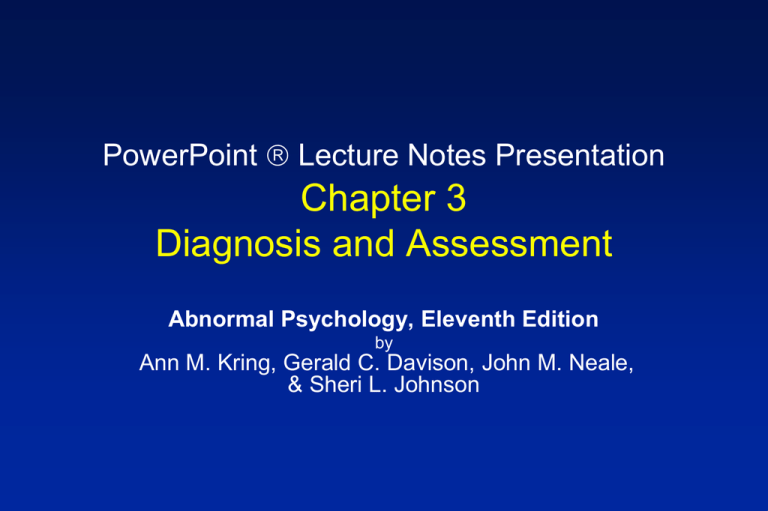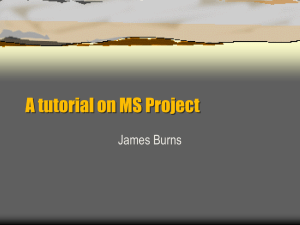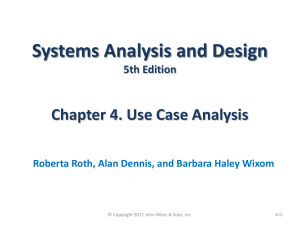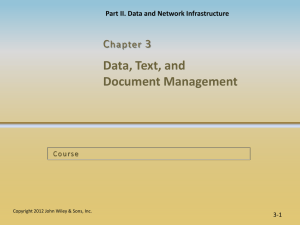
PowerPoint Lecture Notes Presentation
Chapter 3
Diagnosis and Assessment
Abnormal Psychology, Eleventh Edition
by
Ann M. Kring, Gerald C. Davison, John M. Neale,
& Sheri L. Johnson
Diagnosis and Assessment
Diagnosis
» The classification of disorders by symptoms and
signs.
Advantages of diagnosis:
» Facilitates communication among professionals
» Advances the search for causes and treatments
» Cornerstone of clinical care
Copyright 2009 John Wiley & Sons, NY
2
Reliability
Consistency of measurement
» Inter-rater
– Observer agreement
» Test-retest
– Similarity of scores across repeated test administrations or
observations
» Alternate Forms
– Similarity of scores on tests that are similar, but not identical
» Internal Consistency
– Extent to which test items are related to one another
Copyright 2009 John Wiley & Sons, NY
3
Validity
How well does a test measures what it is supposed
to measure?
Content validity
» Extent to which a measure adequately samples the domain
of interest e.g., all of the symptoms of a disorder.
Criterion validity
» Extent to which a measure is associated with another
measure (the criterion)
– Concurrent
Two measures administered at the same point in time
» Hopelessness scale and diagnosis of depression
– Predictive
Ability of the measure to predict another variable measured at
some future point in time
» College GPA and annual salary after graduation
Copyright 2009 John Wiley & Sons, NY
4
Validity
Construct validity (Cronbach & Meehl, 1955)
» A construct is an abstract concept or inferred
attribute
» Involves correlating multiple indirect measures of
the attribute
– e.g., self-report of anxiety correlated with increased HR,
shallow breathing, racing thoughts.
» Important method for evaluating diagnostic
categories
Copyright 2009 John Wiley & Sons, NY
5
DSM-IV-TR
Diagnostic System
Diagnostic and Statistical Manual of
Mental Disorders (DSM-IV-TR)
» 4th edition revised
» Published by American Psychiatric
Association
Multiaxial system
» Diagnosis based on 5 axes or dimensions.
Copyright 2009 John Wiley & Sons, NY
6
Five Axes of DSM-IV
AXIS DESCRIPTION
I
II
III
IV
V
All diagnostic categories except personality
disorders and mental retardation
Personality disorders and mental retardation
General medical conditions
Psychosocial and environmental problems
Global assessment of functioning scale (GAF)
Copyright 2009 John Wiley & Sons, NY
7
Selected Axis I
Diagnostic Categories
Disorders usually first diagnosed in infancy, childhood or
adolescence
» Learning Disorders
» Pervasive Developmental Disorders
Substance-related disorders
» Alcohol-related and Amphetamine-related Disorders
Schizophrenia and other Psychotic Disorders
Anxiety disorders
» Panic, Generalized Anxiety, Obsessive-Compulsive Disorders
Mood disorders
» Major Depressive and Bipolar Disorders
Eating Disorders
» Anorexia Nervosa and Bulimia Nervosa
Copyright 2009 John Wiley & Sons, NY
8
Example: Multiaxial Diagnosis of
Carol S.
Axis I
Major Depressive Disorder
Axis II
Borderline Personality Disorder
Axis III
Thyroid disease
Axis IV
Axis V
Problems with primary support group: marital
separation
GAF = 60 Moderate difficulty in social and
occupational functioning
Copyright 2009 John Wiley & Sons, NY
9
Early Foundations: Emil Kraepelin
(1856-1926)
Pioneered classification of mental illness
based on biological causes
Published 1st psychiatry text (1883)
Mental illness as syndrome
» Cluster of symptoms that co-occur
Proposed two major syndromes
» Dementia praecox
» Manic-depressive psychosis
Copyright 2009 John Wiley & Sons, NY
10
Improvements in the
DSM-IV-TR
1.
Specific diagnostic criteria
» Less vague, more explicit and concrete
than DSM-II (see Table 3.2)
2.
More extensive descriptions
» Essential features
» Associated features (e.g., lab findings)
» Differential diagnosis
Copyright 2009 John Wiley & Sons, NY
11
Improvements in the
DSM-IV-TR
3.
4.
Increasing number of diagnostic
categories
Issues and possible diagnostic
categories in need of further study
Caffeine withdrawal or Premenstrual
Dysphoric Disorder
Copyright 2009 John Wiley & Sons, NY
12
Table 3.2 Descriptions of Mania
in DSM-II vs. DSM-IV-TR
Copyright 2009 John Wiley & Sons, NY
13
Ethnic & Cultural Considerations
Mental illness universal
Culture can influence:
»
»
»
»
Risk factors
Types of symptoms experienced
Willingness to seek help
Availability of treatments
DSM-IV-TR includes:
» Enhanced cultural sensitivity
» Appendix of 25 culture-bound syndromes
– Koro
– Amok
Some researchers endorse looking for
commonalities rather than differences across
cultures
Copyright 2009 John Wiley & Sons, NY
14
Table 3.4 Twelve month prevalence of the
most common diagnoses by country
Copyright 2009 John Wiley & Sons, NY
15
Table 3.3 Number of Diagnostic
Categories per Edition of DSM
Copyright 2009 John Wiley & Sons, NY
16
Categorical
Figure 3.1 Categorical vs.
Dimensional Systems
» Presence/absence of a disorder
– Either you are anxious or you are not
anxious.
Dimensional
» Rank on a continuous quantitative
dimension
– Degree to which a symptom is present
– How anxious are you on a scale of 1 to
10?
Dimensional systems may better
capture an individual’s functioning
Categorical approach has advantages
for research and understanding
Copyright 2009 John Wiley & Sons, NY
17
Figure 3.2 Interrater Reliability
Extent to which
clinicians agree on the
diagnosis.
Copyright 2009 John Wiley & Sons, NY
18
Inter-Rater Reliability of Selected
DSM Diagnoses
For most DSM
diagnostic
categories,
reliability is good
Reliability in
everyday settings
may be lower than
in formal research
settings
Diagnosis
Bipolar Disorder
Major Depression
Schizophrenia
Alcohol Abuse
Any Eating Disorder
Panic Disorder
Avoidant PD
Dependent PD
Copyright 2009 John Wiley & Sons, NY
Kappa
.84
.80
.79
1.0
.77
.65
.97
.86
19
Validity of Diagnostic Categories
Construct validity of
highest concern
Diagnoses are
constructs
» For most disorders, no
lab test available to
diagnose with certainty
Strong construct validity
predicts wide range of
characteristics
Copyright 2009 John Wiley & Sons, NY
20
Table 3.5 Rates of marital distress and missed
work days among people with mental illness in
the past year
Copyright 2009 John Wiley & Sons, NY
21
Criticisms of Classification
Stigma against mental illness
» Treated differently by others
» Difficulty finding a job
Categories do not capture the uniqueness
of a person.
» The disorder does not define the person.
– She is an individual with schizophrenia, not a
“schizophrenic”
Classification may emphasize trivial
similarities
» Relevant information may be overlooked.
Copyright 2009 John Wiley & Sons, NY
22
Possible Changes for DSM-IV
Including a Personal Health Index
Reorganizing categories based on
overlap
Dimensional approach to diagnoses
Organizing diagnoses by causes
Defining disability
Copyright 2009 John Wiley & Sons, NY
23
Psychological Assessment
Techniques employed to:
»
»
»
»
»
Describe client’s problem
Determine causes of problem
Arrive at a diagnosis
Develop a treatment strategy
Monitor treatment progress
Ideal assessment involves multiple measures
and methods
» Interviews, personality inventories, etc.
Copyright 2009 John Wiley & Sons, NY
24
Table 3.7 Major Psychological
Assessment Methods
Copyright 2009 John Wiley & Sons, NY
25
Characteristics of Clinical
Interviews
Interviewer attends to how questions are answered
» Is response accompanied by appropriate emotion?
» Does client fail to answer question?
Paradigm influences information sought
» CBT interviewer focuses on current, rather than early
childhood, events.
Good rapport essential
» Empathy and accepting attitude
Formal (structured) vs. informal
» Structured interviews
– All interviewers ask the same questions in a predetermined
order
– Structured Clinical Interview for Axis I of DSM (SCID)
Copyright 2009 John Wiley & Sons, NY
26
Figure 3.4 Sample Item
from SCID
Copyright 2009 John Wiley & Sons, NY
27
Assessment of Stress
Social Readjustment Rating Scale (SSRS)
» Holmes & Rahe (1967)
» Relies on retrospective ratings
» Stressfulness ratings fixed
Assessment of Daily Experiences (ADE)
» Stone & Neale (1982)
» Monitor and record thoughts and events on a daily
basis
Bedford College Life Events and Difficulties
Schedule (LEDS)
» Semi-structured interview
» Evaluates stressors within the context of each
individual’s circumstances
Copyright 2009 John Wiley & Sons, NY
28
Figure 3.5 Sample of
Assessment of Daily
Experience Scale
Copyright 2009 John Wiley & Sons, NY
29
Figure 3.6 LEDS Life Events Timeline
Copyright 2009 John Wiley & Sons, NY
30
Three Types of Psychological
Tests
Self-report personality Inventories
» Minnesota Multiphasic Personality Inventory (MMPI)
– Yields profile of psychological functioning
– Specific subscales to detect lying and faking “good” or “bad”
Projective Tests
» Rorshach Inkblot Test and Thematic Apperception Test
(TAT)
» Projective hypothesis
– Responses to ambiguous stimuli reflect unconscious processes
Intelligence tests
» Wechsler Adult Intelligence Scale, 3rd Ed (WAIS-III);
Wechsler Intelligence Scale for Children, 3rd Ed (WISC-III)
» Assesses current mental ability
Copyright 2009 John Wiley & Sons, NY
31
Figure 3.7 Hypothetical MMPI-2
Profile
Copyright 2009 John Wiley & Sons, NY
32
Figure 3.8 Rorschach Inkblot Test
Copyright 2009 John Wiley & Sons, NY
33
Behavioral Observation
Observe behavior as it occurs
Sequence of behavior divided into segments
» Antecedents and consequences
Observation often conducted in lab setting
» e.g., romantic partners discuss relationship
problem
– Interaction observed through one-way mirror or
videotaped for later coding
Copyright 2009 John Wiley & Sons, NY
34
Self-Observation
Self monitoring
» Individuals observe and record their own behavior
– e.g., moods, stressful events, thoughts, etc.
Ecological Momentary Assessment (EMA)
» Collection of data in real time using diaries or
PDAs
Reactivity
» The act of observing one’s behavior may alter it
– Desirable behaviors tend to increase whereas
undesirable behaviors decrease
Copyright 2009 John Wiley & Sons, NY
35
Self-report Inventories &
Cognitive Assessment
Format often similar to personality tests
Dysfunctional Attitude Scale (DAS)
» Identifies maladaptive thought patterns
– People will think less of me if I make mistakes
Articulated Thoughts in Simulated
Situations (ATSS)
» Assesses immediate thoughts in specific
situations
Copyright 2009 John Wiley & Sons, NY
36
Neurobiological Assessment:
Brain Imaging
Computerized Axial Tomography (CT or CAT
scan)
» Reveals structural abnormalities by detecting
differences in tissue density.
– e.g., enlarged ventricles
Magnetic Resonance Imaging (MRI)
» Similar to CT but higher quality
» fMRI (functional MRI)
– Images reveal function as well as structure
– Measures blood flow in the brain
(BOLD; blood oxygenation level dependent)
Positron Emission Tomography (PET scan)
» Brain function
Copyright 2009 John Wiley & Sons, NY
37
Neurobiological Assessment:
Neurotransmitter Assessment
Postmortem studies
Metabolite assays
» Metabolite levels
– By-products of neurotransmitter breakdown
found in urine, blood serum or cerebral spinal
fluid
» May not reflect actual level of
neurotransmitter
» Correlational studies
Copyright 2009 John Wiley & Sons, NY
38
Neurobiological Assessment:
Neuropsychological Assessment
Neuropsychologist
» Studies how brain abnormalities affect thinking,
feeling, and behavior
Neuropsychological Tests
» Reveal performance deficits that can indicate
areas of brain malfunction
» Halstead-Reitan battery
– Tactile Performance Test - Time
– Tactile Performance Test - Memory
– Speech Sounds Perception Test
» Luria-Nebraska battery
– Assesses motor skills, tactile & kinesthetic skills, verbal &
spatial skills, expressive & receptive speech, etc.
Copyright 2009 John Wiley & Sons, NY
39
Psychophysiological Assessment
Psychophysiology
» Study of bodily changes that accompany
psychological characteristics or events
Electrocardiogram (EKG)
» Heart rate measured by electrodes placed on chest
Electrodermal responding (skin conductance)
» Sweat-gland activity measured by electrodes
placed on hand.
Electroencephalogram (EEG)
» Brain’s electrical activity measured by electrodes
placed on scalp.
Copyright 2009 John Wiley & Sons, NY
40
Cultural Bias in Assessment
Measures developed for one culture or
ethnic group may not be valid or reliable
for another.
» Not simply a matter of language translation
– Meaning may be lost
Cultural bias can lead to minimizing or
exaggerating psychological problems
Copyright 2009 John Wiley & Sons, NY
41
Strategies to Avoid Bias
Increase graduate students’ sensitivity
to cultural issues
Insure participants’ understanding of
task
Establish rapport
Distinguish “cultural responsiveness”
from “cultural stereotyping” (Lopez,
1994)
Copyright 2009 John Wiley & Sons, NY
42
COPYRIGHT
Copyright 2009 by John Wiley & Sons, New
York, NY. All rights reserved. No part of the
material protected by this copyright may be
reproduced or utilized in any form or by any
means, electronic or mechanical, including
photocopying, recording or by any information
storage and retrieval system, without written
permission of the copyright owner.
Copyright 2009 John Wiley & Sons, NY
43









